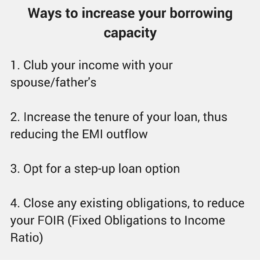[Tmdl.edu.vn] Considering that people often opt for long tenures on their home loans, even a small miscalculation in the loan amount that one opts for, can result in major financial trouble

How much loan should one take? This is a dilemma that most home loan seekers face when buying a home. Taking more loan than needed, can have an adverse impact, warns Rajiv Raj, co-founder and director of CreditVidya. It will result in higher debt and fixed cost, in terms of the interest, for the tenure of the loan, he points out.
var adpushup = window.adpushup = window.adpushup || {};
adpushup.que = adpushup.que || [];
adpushup.que.push(function() {
adpushup.triggerAd(“4cbc6643-b533-4344-bc4b-1c337dc43234”);
});
“Currently, banks fund around 80-85% of the agreement value of the property. An individual can opt for a lower loan amount, if they can raise the funds on their own. Although financing institutions offer home loans for 20 years, the average tenure is around eight to nine years. End-users should take the right amount of debt, to avail of the tax benefits from this transaction. Investors should focus on the return on investment, by factoring in the borrowing cost and appreciation in the property’s price, over the period of time,” he advises.
According to experts, over-leveraging can also impact an applicant’s credit score and future borrowing, for a second home, or loan against property, etc. The repayment track record and utilisation, account for 65% of one’s credit score. Consequently, higher exposure and default on payment, have an adverse impact on credit scores.
The debt-to-income ratio, gives a fair idea about the extent of home loan that one can opt for, reveals an analyst, requesting anonymity. “Debt-to-income ratio is the percentage of your monthly income that you spend, on repaying your outstanding liabilities. In India, the EMI is often 25-40% of the gross monthly income of a household. The general consensus is that the debt-to-income ratio should not be higher than 30%. However, households that earn more, can afford to have a higher debt-to-income ratio,” he explains.
Repayment capacity
According to data available from the Credit Information Bureau Limited (CIBIL), 79% of loans were approved, among customers whose credit score was above 750. The CIBIL score can also be used, to predict the probability of a customer defaulting on his/her loan. A high score can help the applicant to get instant loans in many cases.
[Tmdl.edu.vn] Fixed, Semi-Fixed or Floating Home Loan: Which is the best option?
“Lenders calculate an applicant’s repayment capacity, on the basis of his/her income. In case of salaried individuals, banks generally consider 45-50% of the income as allocation towards home loan repayment. The point to be noted, is that 50% is the maximum FOIR (Fixed obligation-to-income ratio) permitted by lenders. Thus, if the borrower has any existing obligation, it will reduce his/her eligibility for the loan. Lenders normally do not consider obligations that will be repaid within six months, while computing FOIR,” Raj elaborates.
Check out: Info. regarding IFSC code Axis bank
Increasing the borrowing capacity
An applicant can increase amount of loan that s/he is eligible for, in several ways:
- By clubbing one’s income with their spouse/father
- By increasing the tenure of the loan – a higher tenure will reduce the EMI outflow and thus, increase the eligibility
- By opting for a step-up loan option – under this scheme, the EMI is lower in the initial stages of the loan’s tenure and increases, as the applicant’s income increases
- By closing any existing obligations, to reduce one’s FOIR (Fixed Obligations to Income Ratio). Across the world, housing affordability is calculated, according to whether annual housing costs are greater than 30% of the income of a household. Consequently, your EMI should ideally, not be higher than 30% of your monthly income. However, every household is different. So, decide judiciously.
[Tmdl.edu.vn] Read about Indian bank new IFSC code
Source: https://tmdl.edu.vn/us
Copyright belongs to: Tmdl.edu.vn





